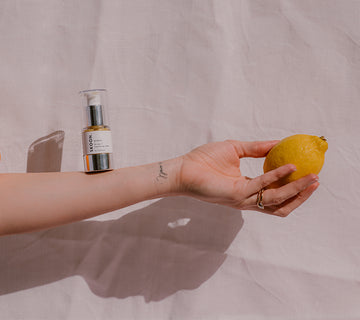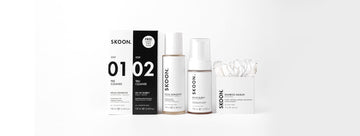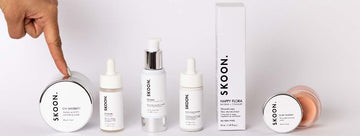When I started reading up again about Vitamin A (retinal) for this blog, the idea suddenly hit! Do a small ‘in-house’ collective trial! If you feel like joining me in putting Vitamin A to the test, here’s an invite. Amazingly enough, I have never used Vitamin A. I can’t think why ever not but I’m a creature of habit and really simply love my current routine.
Table of contents
-
What is Vitamin A?
○ Retinol, retinal and retinoic acid.
○ Takeaway fact -
Benefits of Vitamin A?
○ Clear up acne
○ Curb wrinkles
○ Reduce hyperpigmentation
○ Lessen sebum production
○ Reduce pore size - When will I see results from applying vitamin A?
- What are the side effects of vitamin A in skin care?
- When should I apply skincare products containing Vitamin A?
- Which products should I pair with Vitamin A?
- Vitamin A myths and misconceptions
- Join our vitamin A trial!
Back to Vitamin A, it is not often that I find an ingredient that makes me want to do a happy dance and SKOON.’s Vitamin A (also known as retinaldehyde or retinal for short) deserves two happy dance circuits around the factory!
(Quick fact: retinal is not just retinol by another name - or a typo. There is a profound molecular difference between these two variants of Vitamin A).
The incredible retinal molecule is the complete package when it comes to your skin's nightly repair cycle! But hang on. I’m getting ahead of myself. Happens when I get excited about amazing hero ingredients like retinal!
So without further ado let’s meet the Vitamin A called retinal.
What is Vitamin A?
Vitamin A is a fat-soluble nutrient that plays a vital role in the metabolism of skin cells and collagen production.
When applied topically to the skin, Vitamin A can provide some pretty amazing benefits. More on that later.
For now, let's start with some of the more technical terms and straighten out some of the definitions around Vitamin A.
Let’s start with a word you might have heard before - "retinoids".
Retinoids is a collective term for Vitamin A and all of its derivatives. You will probably have come across these three which are the most common in skincare:
- Retinol (ROL)
- Retinal (RAL) and
- Retinoic acid (RA)
Retinol(ROL) and retinal(RAL) are both over-the-counter (OTC) versions of Vitamin A. It is these two types of Vitamin A that you will commonly find in your skincare. While retinol and retinal are freely available, you will need a prescription from your doctor or skin specialist, for retinoic acid.
Why is this important to know?
Well, it’s key because all benefits from the topical application of Vitamin A are linked to this form of Vitamin A, called retinoic acid.
Now you will naturally want to know where retinol and retinal fit in.
I made this handy little graph to help explain.
When you apply any OTC skincare product that contains Vitamin A, topically it first has to undergo conversion processes involving enzymes:

Your product with retinol: Step 1: Your skin converts the Vitamin A in the form of retinol (ROL) first to retinal(RAL).
Your product with retinol: Step 2: Retinal is then converted to retinoic acid (RA) during the second step.
or
Your SKOON. RETININ: Only Step 2: Retinal(RAL) is converted straight into retinoic acid (RA).
If you look at the flowchart above, you’ll see that retinol(ROL) needs 2 metabolic steps to convert to retinoic acid (RA), and with SKOON.s retinal(RAL), there’s just one quick step to conversion.
Takeaway Fact: all forms of Vitamin A or retinoids in skincare (retinol/retinal) must first be converted into retinoic acid before you get the amazing skin benefits for which Vitamin A is deservedly famous! Retinal, contained in SKOON.’s RETININ Resurfacing Cream, is only one step away from retinoic acid. Now a difference of one step might not seem like much but it does actually have a big impact, as the second step is a much faster conversion than the first and this makes a huge difference in how quickly you will see results!
Keep this in mind later when we cover how to incorporate Vitamin A into your skin care.
Hmm….think we should break for some tea and a snack now – chase away all this chemistry stuff. Here’s a link to my favourite, Pasteis de Nata. Would love if you also shared your favourite sweet treats.

I only eat Portuguese Custard Tarts in doubles ☺ …2, 4, 6…
Benefits of Vitamin A in Skin Care?
Now that we know everything about the chemistry, let's get to the good part - Vitamin A as an all-round superstar, with benefits for almost every skin type and concern.
Let’s dive into some of the benefits of this game-changing skincare ingredient!
It helps to clear up acne
Acne occurs when your skin doesn’t shed cells from the surface or from the lining of the follicles in the same way normal skin does. This causes cells to build up inside the follicles, thickening the lining and resulting in clogged pores, blackheads, and other impactions. Fear not! Vitamin A is here to help!
Firstly retinoic acid is a strong keratolytic (peeling agent) that increases the rate of your skin cell turnover by removing dead cell build-up. This means faster shedding of dead skin cells which in turn means less debris to clog pores.
Secondly, retinoic acid is an excellent drying agent for oily skin and pimples. Less oil means less clogged pores and less “food” for the bacteria P.Acnes that causes the redness and inflammation associated with acne.
Easy to see why RETININ Retinal 0.1% Resurfacing Cream is still the number one go-to product for acne treatment in the SKOON. range.

Kick wrinkles to the curb
Collagen is our natural anti-wrinkle molecule - a structural protein that provides strength, flexibility, and resilience to the skin.
Unfortunately, the production of this lovely protein decreases over time and is the main reason why skin becomes less elastic and thinner with age. This, in turn, makes skin more prone to sagging and wrinkling.
Enter our hero ingredient. Vitamin A stimulates skin to produce and organise new collagen bundles. This helps to increase epidermal thickness, tightening of the skin, and reduces that pesky sagging and wrinkling!
As you may know by now, at SKOON. we’re not into quick-fixes and claims like, “it-will-make your-wrinkles-magically-disappear” but we have received some pretty amazing feedback from customers using RETININ Retinal 0.1% Resurfacing Cream.

Treatment of hyperpigmentation
In sunny South Africa, pigmentation ranks very high as a skin concern. Our warm climate means lots of time spent in the sun - the result: issues with UV damage and pigmentation.
Fortunately, Vitamin A can help! It inhibits the melanin-producing enzyme tyrosinase, interferes with pigment transfer and, as mentioned earlier, speeds up cell turnover rate through potent exfoliation.
The standard treatment for pigmentation involves a combination of exfoliation of existing stained skin and blocking of melanin production to slow down new pigmentation - making Vitamin A sound like a no-brainer.
However, having looked at existing studies, I feel that Vitamin A alone is not a strong enough candidate for the holistic treatment of hyperpigmentation, so for now I am giving it an efficacy score of 5+/10 for its pigment reducing properties.
The “+” allows the score to go up if treatment with Vitamin A is paired with the right ingredients to ramp up efficacy, one of these ingredients being Vitamin C.

Reduces the skin’s sebum production – no more 4 o’clock shine!
Maybe you don’t have acne, but still struggle with T-zone shine? Well, you can still benefit from Vitamin A’s ability to reduce side effects that come along with oily skin.
(Quick fact: If your skin is oily by 11 a.m., especially if you are not wearing makeup, you officially have oily skin.)
Vitamin A is able to penetrate the skin and act on the sebaceous (oil) glands in the skin by reducing their activity – the perfect skin blotter!

Reduce pore size
Pores are created around the time we hit puberty when sebum (oil) really starts flowing through our follicles. The size of your pores are determined by the amount of oil (also called sebum) that your skin produces. A lot of oil flowing through your follicles will stretch them, resulting in what we call “large pores”.
This is hereditary, and not caused by anything you’re doing wrong! In addition, your pores also expand due to aging, as your skin loses its elasticity it stretches and sags, making pores appear larger.
(Quick fact: Pores cannot open or close (or contract – for example like the twitching movement of your muscles.)

So, how can Vitamin A help with large pores? You can shrink pore size by making new skin, and the new skin makes new, smaller pores. You can help make new skin by exfoliating which I’m sure you know by now ☺ gets rid of the top layer of dead skin and stimulates the production of new skin cells.
Being an extremely potent peeling agent, Vitamin A is the perfect candidate for this job - to help your skin with rapid new cell turn over while flushing out debris from your pores.
The last bit is kind of important also. Prevention is better than cure and keeping your follicles clean will prevent them from being stretched in future.
Before I move on, don’t forget that new collagen (and we know this an area where Vitamin A really shines!) will help combat sagging of skin and further opening up of pores.
Pheeeww…even I feel like a mini-break again. Think there are still two pasteis with my name on it before we get on to the next bit.
Just in case there is someone out there that really wants to dig down deep on large pores, here is some more information.
When should I expect to see results?
Vitamin A typically provides results within an 8 -12 week period, so don’t expect overnight results.
For large pores the effect is longer-range and generally takes 6-8 months – I know this seems really long but when it comes to skin texture refining, patience is the main ingredient!
What are the side effects of Vitamin A application?
Here is the best thing about retinal…it converts to retinoic acid within the skin, so typical adverse reactions as described below are either very mild or completely absent. Yayy!! (PS: Also the reason why we are happy at SKOON to recommend our RETININ (with retinal) to customers who have sensitive skin ☺)
If you have used either retinol or retinoic acid in the past you may have experienced "retinoid dermatitis," also referred to as retinoid irritation or retinoid reaction. Vitamin A is a powerful “follicle flusher” and peeling agent and this may cause changes in your skin barrier due to the rapid cell turnover. The knock-on effect is flaking, dry skin, redness and irritation.
With the use of either retinol or retinoc acid, rather start slowly (every 3rd night) and incrementally increase the nightly application frequency.
With SKOON.’s RETININ (retinal) you can start off applying every night and only decrease if you do experience any discomfort. In my experience adverse effects with topical retinal should be absolutely minimal or none at all.
Last but not least : BIG NO NO – sorry, no retinoids if you are pregnant or breastfeeding - and this goes for SKOON’s retinal also.

When should I apply products with Vitamin A?
Vitamin A should form part of your evening skin care routine.
SKOON.’s RETININ Retinal 0.1% Resurfacing Cream is a bright yellow and I always imagine it as a bottle of sunshine to keep you company at night. Quite a horror for pristine white pillows, so keeping a separate coverslip might be a handy tip!
Simply smooth a dollop of RETININ Retinal 0.1% resurfacing cream onto clean skin. Remember, at night only. If you have very dry skin, add 1-2 drops of one of our nutrient rich oil-based concentrates (Glowdrops, Rosehip C+ or Squalane). Or even a scoop of Ruby Marine Overnight Hydrating Mask.
Broad spectrum SPF (or a hat ☺) is recommended for day time use when Vitamin A is topically applied at night. This is because your skin can be more sensitive to sunlight due to the stimulation of new cell growth.
Again worth mentioning - RETININ (or any other topical retinoids for that matter) - is not suitable for use during pregnancy.
Which products should I pair with Vitamin A?
Some products simply have a synergy that is off the charts. In the case of Vitamin A it’s the powerful antioxidant, Vitamin C.
I think of these two potent vitamins as the skin’s dream team.
Vitamin C, an antioxidant powerhouse, is perfect for the morning and helps to even out existing splotches and pigmentation while Vitamin A is your collagen-building- sleeping-buddy.
Although a dream team, these two ingredients should not be used at the same time!
Vitamin C is perfect as part of your morning routine and Vitamin A as part of your night time routine. Easy to remember. Good morning, vitamin C! Good night, vitamin A!

Vitamin A myths and misconceptions
This has been quite a lengthy list of facts so I thought I’d end the blog with some fiction ☺ and look at some common myths about Vitamin A.
Myth 1 - I’m allergic to retinoids due to red, flaky skin once applied.
Red, flaky skin, with an increase in sensitivity, is not generally caused by an allergic reaction to Vitamin A but is rather a side effect of this powerful keratolytic’s peeling action on your skin.
Top tips to curb any potential side effects if you add vitamin A to your routine:
- Stop using granular scrubs
- Eliminate products with a high alcohol content
- Go fragrance free
- Don’t use highly stripping cleansers
Myth 2 - Retinal thins the skin.
The thinning of the skin by topical retinoids is a common misconception but this particular fact belongs to hydrocortisone since repetitive use of strong cortisone creams can cause thinning of the skin.
On the opposite end of the spectrum, you have Vitamin A which, in fact, increases cell turnover, formation of new cells and collagen bundles which leaves you with firmer and more resilient skin.
Where to now?
Time to wrap it up now.
Hats off to you if you made it this far ☺.
As mentioned at the beginning of this post, I am going to test-drive Vitamin A this month. Please join me if you feel inspired to give this wonderful skin vitamin a go.
I like to think of a blog as a collective effort – please leave any notes, anecdotes or just general comments below. At SKOON. we love hearing from you.
So, over to you.






Hi,
I started using Skoon products & so far I’m very happy with how my skin has taken to them. I’ve been meaning to try the Retini VitaminA cream as part of my regimen and will be ordering myself a bottle soon.
P.S. do you deliver in johanneaburg?
You emphasise that Vitamin A and Vitamin C should not be used at the same time, but also recommend applying Retinin and Rosehip C+ concentrate together at night if your skin is dry. Doesn’t the Rosehip C+ also have lots of Vitamin C? Can you apply them at the same time? Or only on nights when you’re not using Retinin?